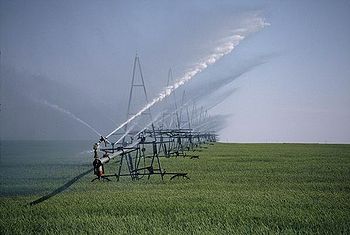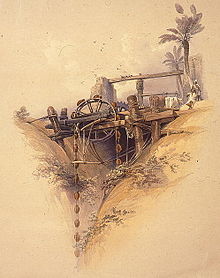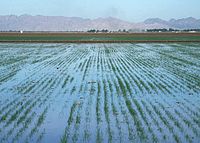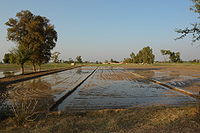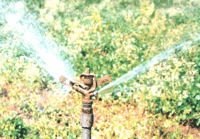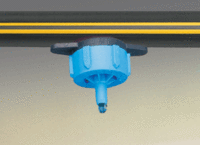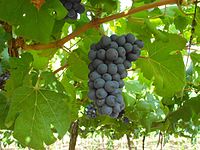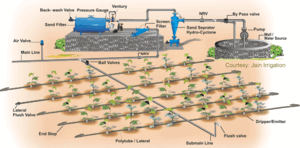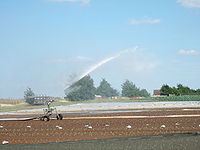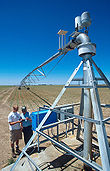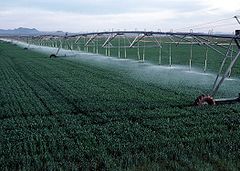- Irrigation
-
For its use in medicine, see Therapeutic irrigation."LEPA" redirects here. For the airport serving Palma de Mallorca, Spain, assigned the ICAO code LEPA, see Palma de Mallorca Airport.
Irrigation may be defined as the science of artificial application of water to the land or soil. It is used to assist in the growing of agricultural crops, maintenance of landscapes, and revegetation of disturbed soils in dry areas and during periods of inadequate rainfall. Additionally, irrigation also has a few other uses in crop production, which include protecting plants against frost,[1] suppressing weed growing in grain fields[2] and helping in preventing soil consolidation.[3] In contrast, agriculture that relies only on direct rainfall is referred to as rain-fed or dryland farming. Irrigation systems are also used for dust suppression, disposal of sewage, and in mining. Irrigation is often studied together with drainage, which is the natural or artificial removal of surface and sub-surface water from a given area.
Irrigation is also a term used in medical/dental fields to refer to flushing and washing out anything with water or another liquid.
Contents
History
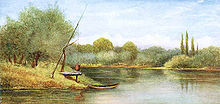 An example of irrigation system common in Indian subcontinent. Artistic impression on the banks of Dal Lake, Kashmir, India.
An example of irrigation system common in Indian subcontinent. Artistic impression on the banks of Dal Lake, Kashmir, India.
Archaeological investigation has identified evidence of irrigation where the natural rainfall was insufficient to support crops.
Perennial irrigation was practised in the Mesopotamian plain whereby crops were regularly watered throughout the growing season by coaxing water through a matrix of small channels formed in the field.[4]
Ancient Egyptians practiced Basin irrigation using the flooding of the Nile to inundate land plots which had been surrounded by dykes. The flood water was held until the fertile sediment had settled before the surplus was returned to the watercourse.[5] There is evidence of the ancient Egyptian pharaoh Amenemhet III in the twelfth dynasty (about 1800 BCE) using the natural lake of the Faiyum Oasis as a reservoir to store surpluses of water for use during the dry seasons, the lake swelled annually from flooding of the Nile.[6]
The Ancient Nubians developed a form of irrigation by using a waterwheel-like device called a sakia. Irrigation began in Nubia some time between the third and second millennium BCE.[7] It largegly depended upon the flood waters that would flow through the Nile River and other rivers in what is now the Sudan.[8]
In "sub-Saharan Africa" irrigation reached the Niger River region cultures and civilizations by the first or second millennium BCE and was based on wet season flooding and water harvesting.[9][10]
Terrace irrigation is evidenced in pre-Columbian America, early Syria India and China.[5] In the Zana Valley of the Andes Mountains in Peru, archaeologists found remains of three irrigation canals radiocarbon dated from the 4th millennium BCE, the 3rd millennium BCE and the 9th century CE. These canals are the earliest record of irrigation in the New World. Traces of a canal possibly dating from the 5th millennium BCE were found under the 4th millennium canal.[11] Sophisticated irrigation and storage systems were developed by the Indus Valley Civilization in present-day Pakistan and North India, including the reservoirs at Girnar in 3000 BCE and an early canal irrigation system from circa 2600 BCE.[12][13] Large scale agriculture was practiced and an extensive network of canals was used for the purpose of irrigation.
Ancient Persia (modern day Iran) as far back as the 6th millennium BCE, where barley was grown in areas where the natural rainfall was insufficient to support such a crop.[14] The Qanats, developed in ancient Persia in about 800 BCE, are among the oldest known irrigation methods still in use today. They are now found in Asia, the Middle East and North Africa. The system comprises a network of vertical wells and gently sloping tunnels driven into the sides of cliffs and steep hills to tap groundwater.[15] The noria, a water wheel with clay pots around the rim powered by the flow of the stream (or by animals where the water source was still), was first brought into use at about this time, by Roman settlers in North Africa. By 150 BCE the pots were fitted with valves to allow smoother filling as they were forced into the water.[16]
The irrigation works of ancient Sri Lanka, the earliest dating from about 300 BCE, in the reign of King Pandukabhaya and under continuous development for the next thousand years, were one of the most complex irrigation systems of the ancient world. In addition to underground canals, the Sinhalese were the first to build completely artificial reservoirs to store water. Due to their engineering superiority in this sector, they were often called 'masters of irrigation'. Most of these irrigation systems still exist undamaged up to now, in Anuradhapura and Polonnaruwa, because of the advanced and precise engineering. The system was extensively restored and further extended during the reign of King Parakrama Bahu (1153–1186 CE).[17]
The oldest known hydraulic engineers of China were Sunshu Ao (6th century BCE) of the Spring and Autumn Period and Ximen Bao (5th century BCE) of the Warring States period, both of whom worked on large irrigation projects. In the Szechwan region belonging to the State of Qin of ancient China, the Dujiangyan Irrigation System was built in 256 BCE to irrigate an enormous area of farmland that today still supplies water.[18] By the 2nd century AD, during the Han Dynasty, the Chinese also used chain pumps that lifted water from lower elevation to higher elevation.[19] These were powered by manual foot pedal, hydraulic waterwheels, or rotating mechanical wheels pulled by oxen.[20] The water was used for public works of providing water for urban residential quarters and palace gardens, but mostly for irrigation of farmland canals and channels in the fields.[21]
In 15th century Korea, the world's first water gauge, uryanggye (Korean:우량계), was invented in 1441. The inventor was Jang Yeong-sil, a Korean engineer of the Joseon Dynasty, under the active direction of the king, Sejong the Great. It was installed in irrigation tanks as part of a nationwide system to measure and collect rainfall for agricultural applications. With this instrument, planners and farmers could make better use of the information gathered in the survey.[22]
In the Americas, extensive irrigation systems were created by numerous groups in prehistoric times. One example is seen in the recent archaeological excavations near the Santa Cruz River in Tucson, Arizona. They have located a village site dating from 4,000 years ago. The floodplain of the Santa Cruz River was extensively farmed during the Early Agricultural period, circa 1200 BC to AD 150. These people constructed irrigation canals and grew corn, beans, and other crops while gathering wild plants and hunting animals.
Present extent
In the middle of the 20th century, the advent of diesel and electric motors led for the first time to systems that could pump groundwater out of major aquifers faster than it was recharged. This can lead to permanent loss of aquifer capacity, decreased water quality, ground subsidence, and other problems. The future of food production in such areas as the North China Plain, the Punjab, and the Great Plains of the US is threatened.
At the global scale, 2,788,000 km² (689 million acres) of agricultural land was equipped with irrigation infrastructure around the year 2000. About 68% of the area equipped for irrigation is located in Asia, 17% in America, 9% in Europe, 5% in Africa and 1% in Oceania. The largest contiguous areas of high irrigation density are found in North India and Pakistan along the rivers Ganges and Indus, in the Hai He, Huang He and Yangtze basins in China, along the Nile river in Egypt and Sudan, in the Mississippi-Missouri river basin and in parts of California. Smaller irrigation areas are spread across almost all populated parts of the world.[23] Only 8 years later in 2008, the scale of irrigated land increased to an estimated total of 3,245,566 km², what is nearly the size of India.[24]
Types
Various types of irrigation techniques differ in how the water obtained from the source is distributed within the field. In general, the goal is to supply the entire field uniformly with water, so that each plant has the amount of water it needs, neither too much nor too little.The modern methods are efficient enough to achieve this goal.
Surface
In surface irrigation systems, water moves over and across the land by simple gravity flow in order to wet it and to infiltrate into the soil. Surface irrigation can be subdivided into furrow, borderstrip or basin irrigation. It is often called flood irrigation when the irrigation results in flooding or near flooding of the cultivated land. Historically, this has been the most common method of irrigating agricultural land.
Where water levels from the irrigation source permit, the levels are controlled by dikes, usually plugged by soil. This is often seen in terraced rice fields (rice paddies), where the method is used to flood or control the level of water in each distinct field. In some cases, the water is pumped, or lifted by human or animal power to the level of the land.
Localized
Localized irrigation is a system where water is distributed under low pressure through a piped network, in a pre-determined pattern, and applied as a small discharge to each plant or adjacent to it. Drip irrigation, spray or micro-sprinkler irrigation and bubbler irrigation belong to this category of irrigation methods.[25]
Drip
Drip irrigation, also known as trickle irrigation, functions as its name suggests.in this system water falls drop by drop just at the position of roots. Water is delivered at or near the root zone of plants, drop by drop. This method can be the most water-efficient method of irrigation[26], if managed properly, since evaporation and runoff are minimized.
In modern agriculture, drip irrigation is often combined with plastic mulch, further reducing evaporation, and is also the means of delivery of fertilizer. The process is known as fertigation.
Deep percolation, where water moves below the root zone, can occur if a drip system is operated for too long or if the delivery rate is too high. Drip irrigation methods range from very high-tech and computerized to low-tech and labor-intensive. Lower water pressures are usually needed than for most other types of systems, with the exception of low energy center pivot systems and surface irrigation systems, and the system can be designed for uniformity throughout a field or for precise water delivery to individual plants in a landscape containing a mix of plant species. Although it is difficult to regulate pressure on steep slopes, pressure compensating emitters are available, so the field does not have to be level. High-tech solutions involve precisely calibrated emitters located along lines of tubing that extend from a computerized set of valves.
Sprinkler
In sprinkler or overhead irrigation, water is piped to one or more central locations within the field and distributed by overhead high-pressure sprinklers or guns. A system utilizing sprinklers, sprays, or guns mounted overhead on permanently installed risers is often referred to as a solid-set irrigation system. Higher pressure sprinklers that rotate are called rotors and are driven by a ball drive, gear drive, or impact mechanism. Rotors can be designed to rotate in a full or partial circle. Guns are similar to rotors, except that they generally operate at very high pressures of 40 to 130 lbf/in² (275 to 900 kPa) and flows of 50 to 1200 US gal/min (3 to 76 L/s), usually with nozzle diameters in the range of 0.5 to 1.9 inches (10 to 50 mm). Guns are used not only for irrigation, but also for industrial applications such as dust suppression and logging.
Sprinklers can also be mounted on moving platforms connected to the water source by a hose. Automatically moving wheeled systems known as traveling sprinklers may irrigate areas such as small farms, sports fields, parks, pastures, and cemeteries unattended. Most of these utilize a length of polyethylene tubing wound on a steel drum. As the tubing is wound on the drum powered by the irrigation water or a small gas engine, the sprinkler is pulled across the field. When the sprinkler arrives back at the reel the system shuts off. This type of system is known to most people as a "waterreel" traveling irrigation sprinkler and they are used extensively for dust suppression, irrigation, and land application of waste water. Other travelers use a flat rubber hose that is dragged along behind while the sprinkler platform is pulled by a cable. These cable-type travelers are definitely old technology and their use is limited in today's modern irrigation projects.
Center pivot
Center pivot irrigation is a form of sprinkler irrigation consisting of several segments of pipe (usually galvanized steel or aluminum) joined together and supported by trusses, mounted on wheeled towers with sprinklers positioned along its length. The system moves in a circular pattern and is fed with water from the pivot point at the center of the arc. These systems are found and used in all parts of the world and allow irrigation of all types of terrain. Newer systems have drop sprinkler heads as shown in the image that follows.
Most center pivot systems now have drops hanging from a u-shaped pipe attached at the top of the pipe with sprinkler heads that are positioned a few feet (at most) above the crop, thus limiting evaporative losses. Drops can also be used with drag hoses or bubblers that deposit the water directly on the ground between crops. Crops are often planted in a circle to conform to the center pivot. This type of system is known as LEPA (Low Energy Precision Application). Originally, most center pivots were water powered. These were replaced by hydraulic systems (T-L Irrigation) and electric motor driven systems (Reinke, Valley, Zimmatic). Many modern sprinklers features GPS devices.[citation needed]
Lateral move (side roll, wheel line)
A series of pipes, each with a wheel of about 1.5 m diameter permanently affixed to its midpoint and sprinklers along its length, are coupled together at one edge of a field. Water is supplied at one end using a large hose. After sufficient water has been applied, the hose is removed and the remaining assembly rotated either by hand or with a purpose-built mechanism, so that the sprinklers move 10 m across the field. The hose is reconnected. The process is repeated until the opposite edge of the field is reached. This system is less expensive to install than a center pivot, but much more labor intensive to operate, and it is limited in the amount of water it can carry. Most systems utilize 4 or 5-inch (130 mm) diameter aluminum pipe. One feature of a lateral move system is that it consists of sections that can be easily disconnected. They are most often used for small or oddly shaped fields, such as those found in hilly or mountainous regions, or in regions where labor is inexpensive.
Sub-irrigation
Subirrigation also sometimes called seepage irrigation has been used for many years in field crops in areas with high water tables. It is a method of artificially raising the water table to allow the soil to be moistened from below the plants' root zone. Often those systems are located on permanent grasslands in lowlands or river valleys and combined with drainage infrastructure. A system of pumping stations, canals, weirs and gates allows it to increase or decrease the water level in a network of ditches and thereby control the water table.
Sub-irrigation is also used in commercial greenhouse production, usually for potted plants. Water is delivered from below, absorbed upwards, and the excess collected for recycling. Typically, a solution of water and nutrients floods a container or flows through a trough for a short period of time, 10–20 minutes, and is then pumped back into a holding tank for reuse. Sub-irrigation in greenhouses requires fairly sophisticated, expensive equipment and management. Advantages are water and nutrient conservation, and labor-saving through lowered system maintenance and automation. It is similar in principle and action to subsurface drip irrigation.
Manual using buckets or watering cans
These systems have low requirements for infrastructure and technical equipment but need high labor inputs. Irrigation using watering cans is to be found for example in peri-urban agriculture around large cities in some African countries.
Automatic, non-electric using buckets and ropes
Besides the common manual watering by bucket, an automated, natural version of this also exist. Using plain polyester ropes combined with a prepared ground mixture can be used to water plants from a vessel filled with water.[27][28][29]
The ground mixture would need to be made depending on the plant itself, yet would mostly consist of black potting soil, vermiculite and perlite. This system would (with certain crops) allow to save expenses as it does not consume any electricity and only little water (unlike sprinklers, water timers, ...). However, it may only be used with certain crops (probably mostly larger crops that do not need a humid environment; perhaps e.g. paprikas).[citation needed]
Using water condensed from humid air
In countries where at night, humid air sweeps the countryside, water can be obtained from the humid air by condensation onto cold surfaces. This is for example practiced in the vineyards at Lanzarote using stones to condense water or with various fog collectors based on canvas or foil sheets.
Sources of irrigation water
Sources of irrigation water can be groundwater extracted from springs or by using wells, surface water withdrawn from rivers, lakes or reservoirs or non-conventional sources like treated wastewater, desalinated water or drainage water. A special form of irrigation using surface water is spate irrigation, also called floodwater harvesting. In case of a flood (spate) water is diverted to normally dry river beds (wadis) using a network of dams, gates and channels and spread over large areas. The moisture stored in the soil will be used thereafter to grow crops. Spate irrigation areas are in particular located in semi-arid or arid, mountainous regions. While floodwater harvesting belongs to the accepted irrigation methods, rainwater harvesting is usually not considered as a form of irrigation. Rainwater harvesting is the collection of runoff water from roofs or unused land and the concentration of this. Some of Ancient India's water systems were pulled by oxen.
Around 90% of wastewater produced globally remains untreated, causing widespread water pollution, especially in low-income countries. Increasingly, agriculture is using untreated wastewater as a source of irrigation water. Cities provide lucrative markets for fresh produce, so are attractive to farmers. However, because agriculture has to compete for increasingly scarce water resources with industry and municipal users (see Water scarcity below), there is often no alternative for farmers but to use water polluted with urban waste, including sewage, directly to water their crops. There can be significant health hazards related to using water loaded with pathogens in this way, especially if people eat raw vegetables that have been irrigated with the polluted water. The International Water Management Institute has worked in India, Pakistan, Vietnam, Ghana, Ethiopia, Mexico and other countries on various projects aimed at assessing and reducing risks of wastewater irrigation. They advocate a ‘multiple-barrier’ approach to wastewater use, where farmers are encouraged to adopt various risk-reducing behaviours. These include ceasing irrigation a few days before harvesting to allow pathogens to die off in the sunlight, applying water carefully so it does not contaminate leaves likely to be eaten raw, cleaning vegetables with disinfectant or allowing fecal sludge used in farming to dry before being used as a human manure.[30] The World Health Organization has developed guidelines for safe water use.
Water scarcity
Fifty years ago, the common perception was that water was an infinite resource. At that time, there were fewer than half the current number of people on the planet. People were not as wealthy as today, consumed fewer calories and ate less meat, so less water was needed to produce their food. They required a third of the volume of water we presently take from rivers. Today, the competition for water resources is much more intense. This is because there are now more than seven billion people on the planet, their consumption of water-thirsty meat and vegetables is rising, and there is increasing competition for water from industry, urbanisation and biofuel crops. To avoid a global water crisis, farmers will have to strive to increase productivity to meet growing demands for food, while industry and cities find ways to use water more efficiently.[31]
Successful agriculture is dependent upon farmers having sufficient access to water. However, water scarcity is already a critical constraint to farming in many parts of the world. With regards to agriculture, the World Bank targets food production and water management as an increasingly global issue that is fostering a growing debate.[32] Physical water scarcity is where there is not enough water to meet all demands, including that needed for ecosystems to function effectively. Arid regions frequently suffer from physical water scarcity. It also occurs where water seems abundant but where resources are over-committed. This can happen where there is overdevelopment of hydraulic infrastructure, usually for irrigation. Symptoms of physical water scarcity include environmental degradation and declining groundwater. Economic scarcity, meanwhile, is caused by a lack of investment in water or insufficient human capacity to satisfy the demand for water. Symptoms of economic water scarcity include a lack of infrastructure, with people often having to fetch water from rivers for domestic and agricultural uses. Some 2.8 billion people currently live in water-scarce areas.[33]
How an in-ground irrigation system works
Most commercial and residential irrigation systems are "in ground" systems, which means that everything is buried in the ground. With the pipes, sprinklers, emitters (drippers), and irrigation valves being hidden, it makes for a cleaner, more presentable landscape without garden hoses or other items having to be moved around manually. This does, however, create some drawbacks in the maintenance of a completely buried system.
Controllers, zones, and valves
Most irrigation systems are divided into zones. A zone is a single irrigation valve and one or a group of drippers or sprinklers that are connected by pipes or tubes. Irrigation systems are divided into zones because there is usually not enough pressure and available flow to run sprinklers for an entire yard or sports field at once. Each zone has a solenoid valve on it that is controlled via wire by an irrigation controller. The irrigation controller is either a mechanical (now the "dinosaur" type) or electrical device that signals a zone to turn on at a specific time and keeps it on for a specified amount of time. "Smart Controller" is a recent term used to describe a controller that is capable of adjusting the watering time by itself in response to current environmental conditions. The smart controller determines current conditions by means of historic weather data for the local area, a soil moisture sensors (water potential or water content), rain sensor, or in more sophisticated systems satellite feed weather station, or a combination of these.
Emitters and sprinklers
When a zone comes on, the water flows through the lateral lines and ultimately ends up at the irrigation emitter (drip) or sprinkler heads. Many sprinklers have pipe thread inlets on the bottom of them which allows a fitting and the pipe to be attached to them. The sprinklers are usually installed with the top of the head flush with the ground surface. When the water is pressurized, the head will pop up out of the ground and water the desired area until the valve closes and shuts off that zone. Once there is no more water pressure in the lateral line, the sprinkler head will retract back into the ground. Emitters are generally laid on the soil surface or buried a few inches to reduce evaporation losses.
Problems in irrigation
- Main article: Environmental impacts of irrigation
Irrigation can lead to a number of problems:[34]
- Competition for surface water rights.
- Depletion of underground aquifers.
- Ground subsidence (e.g. New Orleans, Louisiana)
- Underirrigation or irrigation giving only just enough water for the plant (e.g. in drip line irrigation) gives poor soil salinity control which leads to increased soil salinity with consequent build up of toxic salts on soil surface in areas with high evaporation. This requires either leaching to remove these salts and a method of drainage to carry the salts away. When using drip lines, the leaching is best done regularly at certain intervals (with only a slight excess of water), so that the salt is flushed back under the plant's roots.[35][36]
- Overirrigation because of poor distribution uniformity or management wastes water, chemicals, and may lead to water pollution.
- Deep drainage (from over-irrigation) may result in rising water tables which in some instances will lead to problems of irrigation salinity requiring watertable control by some form of subsurface land drainage.[37][38]
- Irrigation with saline or high-sodium water may damage soil structure owing to the formation of alkaline soil
Academic resources
- Irrigation Science, ISSN: 1432-1319 (electronic) 0342-7188 (paper), Springer
- Journal of Irrigation and Drainage Engineering, ISSN: 0733-9437, ASCE Publications
Irrigation by country
Africa Asia Afghanistan · China · Iran · Iraq · India · Israel · Kazakhstan · Pakistan · Russia · Saudi Arabia · Syria · Turkey · TurkmenistanEurope RussiaLatin America and Caribbean North America Canada · United StatesOceania Miscellaneous See also
- Surface irrigation
- Agricultural science
- Aquifer
- Deficit irrigation
- Evapotranspiration
- Farm water
- Geohydrology
- Gezira Scheme
- Groundwater
- Irrigation district
- Paddy field
- Qanat
- Nano Ganesh
- Transvasement
- Plastic pressure pipe systems
- Water management
- Lift irrigation schemes
- Irrigation management
- Irrigation of alluvial fans
- Irrigation statistics
- Irrigation district
- Environmental impact of irrigation
- Coastal sediment supply
- Leaf Sensor
- Tidal irrigation
- List of countries by irrigated land area
References
- ^ Snyder, R. L.; Melo-Abreu, J. P. (2005). "Frost protection: fundamentals, practice, and economics – Volume 1" (PDF). Food and Agriculture Organization of the United Nations. ISSN: 1684-8241.. ftp://ftp.fao.org/docrep/fao/008/y7223e/y7223e00.pdf.
- ^ Williams, J. F.; S. R. Roberts, J. E. Hill, S. C. Scardaci, and G. Tibbits. "Managing Water for Weed Control in Rice". UC Davis, Department of Plant Sciences. http://www.plantsciences.ucdavis.edu/uccerice/WATER/water.htm. Retrieved 2007-03-14.
- ^ Arid environments becoming consolidated
- ^ Hill, Donald: A History of Engineering
- ^ a b p19 Hill
- ^ "Amenemhet III". Britannica Concise. http://concise.britannica.com/ebc/article-9006076/Amenemhet-III. Retrieved 2007-01-10.
- ^ Ancient civilizations of Africa By G. Mokhtar, Unesco. International Scientific Committee for the Drafting of a General History of Africa. Page 309
- ^ The Earth and Its Peoples, Volume I: A Global History, to 1550 By Richard Bulliet, Pamela Kyle Crossley, Daniel Headrick, Steven Hirsch. Pages 53-56.
- ^ Traditional technologies
- ^ Africa, Emerging Civilizations In Sub-Sahara Africa. Various Authors; Edited By: R. A. Guisepi
- ^ Dillehay TD, Eling HH Jr, Rossen J (2005). "Preceramic irrigation canals in the Peruvian Andes". Proceedings of the National Academy of Sciences 102 (47): 17241–4. doi:10.1073/pnas.0508583102. PMC 1288011. PMID 16284247. http://www.pubmedcentral.nih.gov/articlerender.fcgi?tool=pmcentrez&artid=1288011.
- ^ Rodda, J. C. and Ubertini, Lucio (2004). The Basis of Civilization - Water Science? pg 161. International Association of Hydrological Sciences (International Association of Hydrological Sciences Press 2004).
- ^ "Ancient India Indus Valley Civilization". Minnesota State University "e-museum". http://www.mnsu.edu/emuseum/prehistory/india/indus/elements.html. Retrieved 2007-01-10.
- ^ The History of Technology – Irrigation. Encyclopædia Britannica, 1994 edition.
- ^ "Qanat Irrigation Systems and Homegardens (Iran)". Globally Important Agriculture Heritage Systems. UN Food and Agriculture Organization. http://www.fao.org/sd/giahs/other_iran1_desc.asp. Retrieved 2007-01-10.
- ^ Encyclopædia Britannica, 1911 and 1989 editions
- ^ de Silva, Sena (1998). "Reservoirs of Sri Lanka and their fisheries". UN Food and Agriculture Organization. http://www.fao.org/docrep/003/T0028E/T0028E03.htm. Retrieved 2007-01-10.
- ^ China – history. Encyclopædia Britannica,1994 edition.
- ^ Needham, Joseph (1986). Science and Civilization in China: Volume 4, Physics and Physical Technology, Part 2, Mechanical Engineering. Taipei: Caves Books Ltd. Pages 344-346.
- ^ Needham, Volume 4, Part 2, 340-343.
- ^ Needham, Volume 4, Part 2, 33, 110.
- ^ Baek Seok-gi 백석기 (1987). Jang Yeong-sil 장영실. Woongjin Wiin Jeon-gi 웅진위인전기 11. Woongjin Publishing Co., Ltd.
- ^ Siebert, S.; J. Hoogeveen, P. Döll, J-M. Faurès, S. Feick, and K. Frenken (2006-11-10). "The Digital Global Map of Irrigation Areas – Development and Validation of Map Version 4" (PDF). Tropentag 2006 – Conference on International Agricultural Research for Development. Bonn, Germany. http://www.tropentag.de/2006/abstracts/full/211.pdf. Retrieved 2007-03-14.
- ^ CIA - Central Intelligence Agency. "The World Factbook". https://www.cia.gov/library/publications/the-world-factbook/geos/xx.html. Retrieved 2011-10-30.
- ^ Frenken, K. (2005). "Irrigation in Africa in figures – AQUASTAT Survey – 2005" (PDF). Food and Agriculture Organization of the United Nations. ISBN 92-5-105414-2. ftp://ftp.fao.org/agl/aglw/docs/wr29_eng.pdf. Retrieved 2007-03-14.
- ^ Provenzano, Giuseppe (2007). "Using HYDRUS-2D Simulation Model to Evaluate Wetted Soil Volume in Subsurface Drip Irrigation Systems". J. Irrig. Drain Eng. 133 (4): 342–350. doi:10.1061/(ASCE)0733-9437(2007)133:4(342).
- ^ polyester ropes natural irrigation technique
- ^ Polyester rope natural irrigation technique 2
- ^ DIY instructions for making sel-watering system using ropes
- ^ Wastewater use in agriculture: Not only an issue where water is scarce! International Water Management Institute, 2010. Water Issue Brief 4
- ^ Chartres, C. and Varma, S. Out of water. From Abundance to Scarcity and How to Solve the World’s Water Problems FT Press (USA), 2010
- ^ "Reengaging in Agricultural Water Management: Challenges and Options". The World Bank. pp. 4–5. http://water.worldbank.org/water/publications/reengaging-agricultural-water-management-challenges-and-options. Retrieved 2011-30-10.
- ^ Molden, D. (Ed). Water for food, Water for life: A Comprehensive Assessment of Water Management in Agriculture. Earthscan/IWMI, 2007.
- ^ ILRI, 1989, Effectiveness and Social/Environmental Impacts of Irrigation Projects: a Review. In: Annual Report 1988, International Institute for Land Reclamation and Improvement (ILRI), Wageningen, The Netherlands, pp. 18 - 34 . On line: [1]
- ^ EOS magazine, september 2009
- ^ World Water Council
- ^ Drainage Manual: A Guide to Integrating Plant, Soil, and Water Relationships for Drainage of Irrigated Lands. Interior Dept., Bureau of Reclamation. 1993. ISBN 0-16-061623-9
- ^ "Free articles and software on drainage of waterlogged land and soil salinity control in irrgated land". http://www.waterlog.info. Retrieved 2010-07-28.
External links
- "Irrigation techniques". USGS. http://ga.water.usgs.gov/edu/irmethods.html. Retrieved December 8, 2005.
- Sulama Sistemleri Portalı — 19th century Irrigation in India
- Royal Engineers Museum — 19th century Irrigation in India
- International Commission on Irrigation and Drainage (ICID)
- Irrigation at the Water Quality Information Center, U.S. Department of Agriculture
- AQUASTAT — FAO's global information system on water and agriculture
- "Lamp Wick Solves Problem of Citrus Irrigation" Popular Mechanics, November 1930
- World Bank report on Agricultural water management Irrigation is discussed in chps. 1&4.
 This article incorporates text from a publication now in the public domain: Chisholm, Hugh, ed (1911). Encyclopædia Britannica (11th ed.). Cambridge University Press.
This article incorporates text from a publication now in the public domain: Chisholm, Hugh, ed (1911). Encyclopædia Britannica (11th ed.). Cambridge University Press.
Wikimedia Foundation. 2010.

